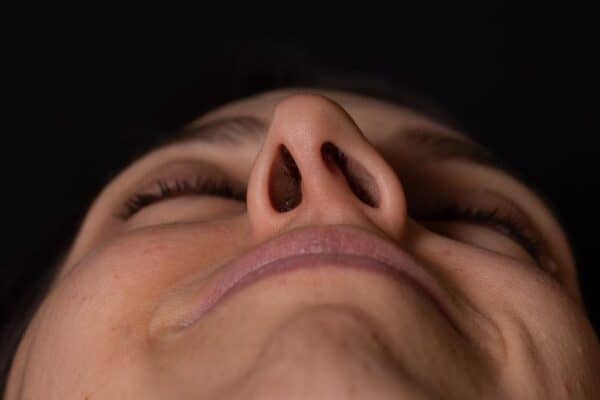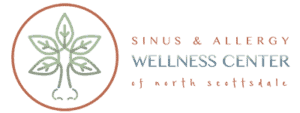Experienced Care for Deviated Septum in Scottsdale
Deviated Septum Treatment in Scottsdale, AZ FAQ
Your two nostrils are divided in half by bone and a thin piece of cartilage called the septum. Normally, the septum is located in the center of your nose.
When the septum is displaced or off-center, it’s called a deviated septum. A septum that’s severely displaced can block the nasal passage. As a result, airflow is limited, and it’s hard to breathe.
A septum that’s mildly displaced may not cause any symptoms. In some patients, a deviated septum worsens the symptoms normally caused by a cold or upper respiratory tract infection. The symptoms you may experience from a deviated septum include:
- Nasal congestion
- Blocked nostril(s)
- Nosebleeds
- Sinus infections
- Difficulty breathing
- Postnasal drip
A deviated septum increases your risk of developing a sinus infection and chronic sinusitis. When that happens, you’ll have additional symptoms, such as sinus headaches and facial pain and pressure.
If your septum is only minimally deviated, antihistamines and decongestants may be all you need to maintain clear nasal passageways. Otherwise, there’s only one treatment: septoplasty.
Septoplasty is an outpatient surgical procedure that straightens your septum and ensures it’s in the middle of your nose. During your procedure, Dr. Gergits trims and repositions the tissue. In some cases, he may need to replace some of the cartilage.
Sometimes a deviated septum is caused by crooked bones pushing against the cartilage. If you have that problem, Dr. Gergits can reposition the bones, and if needed, he can place extra cartilage along the bones to maintain their position.
After your surgery, you’ll need to avoid blowing your nose, steer clear of strenuous activities, and sleep with your head elevated. It takes several days for the swelling to go down, but most patients are back to school or work in a week.
It takes time for the cartilage and bones inside your nose to heal. While they heal, their appearance may change slightly. The tissues are typically stable in 3-6 months. However, they can continue healing and changing for a year.
If you suffer with symptoms due to a deviated septum, call Sinus & Allergy Wellness Center or book an appointment online.


What is a Deviated Septum?
A deviated septum is a condition that occurs when the nasal septum is displaced, usually to one side. Your two nostrils are divided in half by bone and a thin piece of cartilage called the septum. Usually, the septum is located in the center of your nose. When the septum is displaced or off-center, it’s called a deviated septum. A septum that’s severely displaced can block the nasal passage. As a result, airflow is limited, and it’s hard to breathe. Severe misalignment can require deviated septum treatment.
Deviated Septum Causes
A deviated septum is caused by the nasal septum being displaced to one side. Causes can include a condition present at birth or an injury to the nose, such as trauma from a contact sport.
Deviated Septum Symptoms
A septum that’s mildly displaced may not cause any symptoms. In some patients, a deviated septum worsens the symptoms usually caused by a cold or upper respiratory tract infection. A deviated septum increases your risk of developing a sinus infection and chronic sinusitis. You’ll have additional symptoms, such as sinus headaches, facial pain, and pressure when that happens. The symptoms you may experience from a deviated nasal septum include:
- Nasal congestion
- Blocked nostrils
- Nosebleeds
- Sinus infections
- Difficulty breathing
- Postnasal drip
Deviated Septum Treatment Options
If your septum is only mildly deviated, antihistamines and decongestants may be enough to help keep your nasal passageways clear. In more severe cases, septoplasty may be recommended. Septoplasty is an outpatient procedure designed to straighten the septum and improve nasal airflow. During the procedure, Dr. Gergits carefully trims and repositions nasal tissue. In some cases, he may need to replace sections of cartilage. If crooked nasal bones are contributing to the deviation, he can reposition the bones — and if needed, place extra cartilage to help maintain their alignment.

What to Expect From Deviated Septum Surgery
After your surgery, you’ll need to avoid blowing your nose, steer clear of strenuous activities, and sleep with your head elevated. It takes several days for the swelling to go down, but most patients return to school or work in a week. It takes time for the cartilage and bones inside your nose to heal. While they heal, their appearance may change slightly. The tissues are typically stable in three to six months. However, deviated septum surgery recovery can continue for a year. If you suffer from symptoms due to a deviated septum, call Sinus & Allergy Wellness Center or book an appointment.
Contact Sinus & Allergy Wellness Center Today
Sinus & Allergy Wellness Center’s experienced team uses advanced technology to help treat deviated septum conditions and improve nasal airflow. It is our mission to help patients live and breathe more comfortably through personalized ENT care. To schedule a consultation with our team, contact us today.



